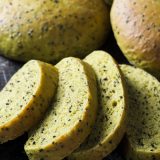The most compelling revelation for those of us who travel and eat for a living is that the world of bread is breathtaking. Flatbreads, other than pizza and tortillas, are mostly unknown in our country—to say nothing of the all-purpose Moroccan khobz, the rice flour banana bread of Liberia or, in this case, the slightly sweet, turmeric-colored ka’ak asfar bread of Palestine.
I had my first taste of the latter in the small hill town of Rameh in a back-of-the-store bakery run by Laya Sama’an. The name of her bakery is Zaytoona, which means olive. (Rameh village is known for its olive groves—and the olive oil they produce—so that served as the inspiration for her bakery’s name.) As I walked in, Sama’an was showing off her baking skills, working with virtually transparent dough to fashion small cheese-stuffed parcels that were shallow-fried. Delicious.
The star of the show, however, was the ka’ak asfar, an Easter bread that is tinted yellow with turmeric and flavored with mahlab (ground cherry pits that offer a distinctive cherry/bitter almond flavor), anise, and nigella and sesame seeds. Though mahlab is a common ingredient in the Middle East, it is hard to find here in the U.S., so a bit of almond extract is a reasonable substitute. Nigella seeds offer a savory, almost oniony flavor, but these are also optional. For our version of ka’ak asfar, all you really need are sesame seeds, aniseed and turmeric.
In Sama’an’s kitchen, the bread is decorated using a wooden mold and baked in small-ish rounds. The mold is optional; we simply fashioned the dough into 5-inch circles, then dimpled the top with our fingers. The dough does contain ½ cup of sugar—it is a slightly sweet dough—along with ½ cup of olive oil for texture and richness. Otherwise, it was business as usual. Allow an hour for the rise, divide and shape into rounds, and then another half-hour for a second rise. The rolls are baked in a 400°F oven in under 15 minutes.
The lesson was clear—with a few additions and change-ups, everyday bread baking can be turned into something extraordinary. Sweet and savory, with a hint of almond and the bright color of turmeric, ka’ak asfar is the answer to the question we often ask here at Milk Street: “How can we change the way we bake?” As it turns out, Laya Sama’an in a small bakery in the town of Rameh has the answer.
A Holiday Bread for Every Season
Christopher Kimball

Get the Recipe
Palestinian-Style Turmeric Bread (Ka’ak Asfar)
During our trip to Rameh, Reem Kassis (author of “The Palestinian Table”) took us to Zaytoona bakery. Here, we got a taste of ka’ak asfar, a sunny yellow Easter bread customarily decorated using a patterned mold.
Photos: Christopher Kimball







